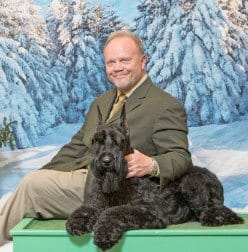
Home » The Giant Schnauzer | It’s All About the Breed Standard
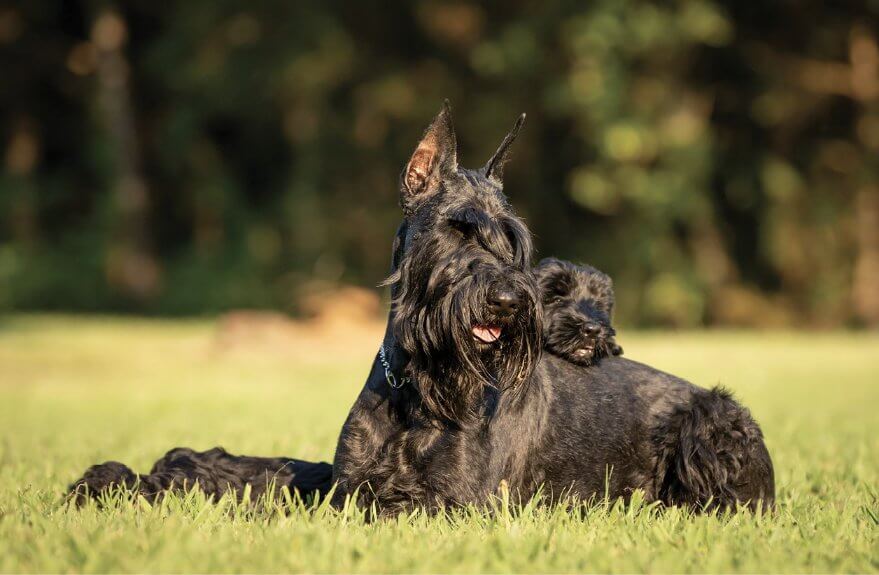
The Giant Schnauzer – It’s All About the Breed Standard (A version of this article originally appeared as a series in “Giant Steps.”)
The Breed Standard for any particular breed is both the blueprint and a schematic for that breed. It tells us how the breed should be constructed, and in some breeds, such as ours, how that breed should be “wired.” Our Standard does, indeed, devote a significant portion to the breed’s ideal temperament.
When a judge enters the ring to pass judgment on our exhibits, the purpose is to select the best breeding stock. Each exhibit is judged against the ideal type for that breed, using the Standard for guidance. The Standard alone is the measuring stick for the breed, and in theory, the individuals are not judged against one another; rather, by how well they conform as an individual to the Standard. The judge has been licensed by AKC to judge each breed that he or she has been hired to preside over. Judges are interviewed and tested on each Standard before being given the breed.
The AKC Breed Standard belongs to, you guessed it, the AKC. The Standard is maintained by the recognized parent club, but any changes have to be approved by AKC. Changing the Standard is not an easy process and should be carefully considered before diving into the process. The Judges’ Education Committee is charged with presenting the Standard to prospective judges in a way that enables them to understand the nuances of the Standard, and hopefully, have an understanding of breed type. It is not our place to rewrite the Standard or change it in any way. We simply apply it as written.
I would like to briefly touch on different aspects of the Giant Schnauzer Breed Standard, the reason for having a written Standard, and how the Standard is applied by judges in the conformation ring. Quotes directly from the Standard are in Bold Italic.
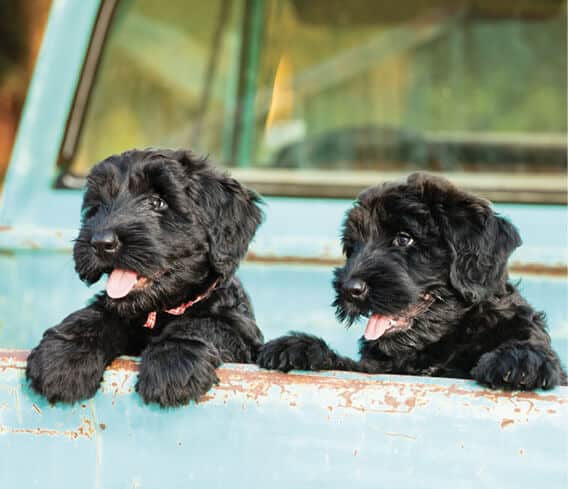
The General Description, basically, describes what a breed should look like and it offers a guideline for understanding breed type:
The Giant Schnauzer should resemble, as nearly as possible, in general appearance, a larger and more powerful version of the Standard Schnauzer, on the whole a bold and valiant figure of a dog. Robust, strongly built, nearly square in proportion of body length to height at withers, active, sturdy and well muscled. Temperament which combines spirit and alertness with intelligence and reliability. Composed, watchful, courageous, easily trained, deeply loyal to family, playful, amiable in repose, and a commanding figure when aroused. The sound, reliable temperament, rugged build, and dense weather-resistant wiry coat make for one of the most useful, powerful, and enduring working breeds.
This paragraph effectively describes both the physical and intellectual traits of the Giant Schnauzer, starting with the opening sentence. The breed does, in fact, resemble a larger, more powerful version of the Standard Schnauzer. The word “version” is important in this sentence because, although both breeds are basically square in proportion, the Standard Schanuzer appears a bit more compact than the Giant. I believe the reason for this lies in the genetic mixture of the Giant. The German Mastiff, now known as the Great Dane, is believed to have been part of the makeup of the Giant in order to gain height. This factor had the effect of giving the Giant a proportionally longer leg bone than that of the Standard Schnauzer.
The second sentence states that the Giant is nearly square in proportion of body length to height at withers. Further into the Standard, the proportions given are exactly square, so this is actually a minor discrepancy within our Standard.
The third and fourth sentences in the General Description go into detail about the temperament that the Giant must possess. This aspect of our breed must never be diminished or disregarded, as it is such an integral part of what makes a Giant a Giant.
The last sentence in the General Description eloquently puts into perspective why the combination of the Giant’s temperament, its build, and its dense, weather-resistant, wiry coat make it such a versatile working dog. Note the order of important aspects listed in that sentence. I don’t think it is a coincidence that temperament is mentioned first.
Remember the history of our breed and the purpose for which it was developed; driving cattle through the Bavarian Alps. Giants had to be strong enough to drive cattle as well as to protect both the cattle and the people who owned them. They had to possess enough stamina to move at a trot all day over rough terrain. These factors were combined to produce what we as fanciers have come to appreciate; an exceptionally versatile, working dog.
I believe that any dog person not already introduced to the Giant could form a reasonably correct image of how the Giant appears, simply by reading the General Description.
The Breed Standard states that the Head is:
Strong, rectangular in appearance, and elongated; narrowing slightly from the ears to the eyes, and again from the eyes to the tip of the nose. The total length of the head is about one-half the length of the back (withers to set-on of tail). The head matches the sex and substance of the dog. The top line of the muzzle is parallel to the top line of the skull; there is a slight stop which is accentuated by the eyebrows.
Most of this is straight-forward. The point I wish to explore is the length of the head. The Standard states that it is “about” one-half the length of the back. The Standard does not indicate that the length of the head “must be at least” one-half the length of the back. I am concerned that exhibits should not be unnecessarily penalized for having too short a head. The Standard even goes so far as to define the back as being the distance from withers to set-on of tail. Considering that the set-on of tail is somewhat in front of the tail, the defined length is much shorter than the overall length of the body. As much as anyone, I appreciate a beautiful, long head. That detail is often the defining characteristic that can give a good exhibit the advantage it needs to win, when all else is equal. Generally speaking, however, a dog shouldn’t be penalized if the head isn’t exaggerated.
Other aspects of the head include the Skull, Cheeks, Bite, Ears, and Eyes:
Skull – (Occiput to Stop). Moderately broad between the ears: occiput not too prominent. Top of skull flat; skin unwrinkled.
Basically, the skull should not be dome shaped nor should there be a presence of excess skin.
Cheeks – Flat, but with well-developed chewing muscles; there is no “cheekiness” to disturb the rectangular head appearance (with beard).
How can the chewing muscles be well-developed without appearing cheeky? If you look from overhead, the cheeks shouldn’t protrude farther than the edges of the skull.
Muzzle – Strong and well filled under the eyes: both parallel and equal in length to the topskull; ending in a moderately blunt wedge. The nose is large, black, and full. The lips are tight, and not overlapping, black in color.
This is a very similar description to that of other breeds. The Doberman Pinscher Standard is very similar, yet the Giant possesses a slightly broader muzzle that allows for large, strong teeth.
Bite – A full complement of sound white teeth (6/6 incisors, 2/2 canines, 8/8 premolars, 4/6 molars) with a scissors bite. The upper and lower jaws are powerful and well formed. Disqualifying Faults – Overshot or undershot.
This is generally a strong suit of the breed. Giants typically have large, strong teeth, nice broad jaws, and good occlusion.
Ears – When cropped, identical in shape and length with pointed tips. They are in balance with the head and are not exaggerated in length. They are set high on the skull and carried perpendicularly at the inner edges with as little bell as possible along the outer edges. When uncropped, the ears are V-shaped button ears of medium length and thickness, set high and carried rather high and close to the head.
Uncropped ears are a little more difficult to judge as there are several possible faults; being long, houndy or carried too low.
Eyes – Medium size, dark brown and deep-set. They are oval in appearance and keen in expression with lids fitting tightly. Vision is not impaired nor eyes hidden by too long eyebrows.
Many of us, myself included, tend to leave so much eyebrow that the eyes can’t be seen without pulling the hair back. The eyes really are beautiful and expressive. I’ve always felt that when I look into the eyes of a Giant, there’s an intelligent, soulful being looking back.
Neck – Strong and well arched, of moderate length, blending cleanly into the shoulders, and with the skin fitting tightly at the throat; in harmony with the dog’s weight and build.
Two words that I’d like to point out are “moderate” and “harmony.” The fact that it’s of moderate length and in harmony with the dog’s build all goes back to the fact that all aspects of this breed are predicated on its square, compact build.
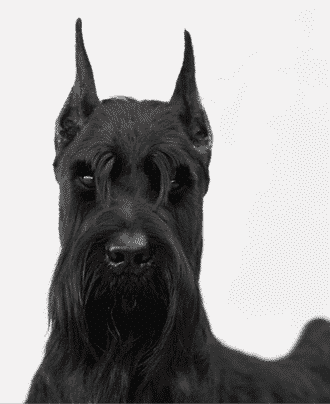
Compact, substantial, short-coupled, and strong, with great power and agility. The height at the highest point of the withers equals the body length from breastbone to point of rump. The loin section is well developed, as short as possible for compact build.
A square build is the most efficient for a working dog, assuming all aspects are correct. It’s imperative that the angulation of both front and rear assemblies is adequate, to ensure proper movement. Over-angulation creates movement faults in order to compensate for over-reaching, while under-angulation is not as efficient because it requires extra movement to accomplish the same forward locomotion.
Understanding the build of a Giant requires one to have a basic familiarity with the history of the breed. It was bred specifically to drive cattle through the Bavarian Alps. It was also the protector of the farmers, their families, and their possessions. This is why we see adjectives such as strong, compact, robust, and moderate all used to describe the breed. It must be strong enough to accomplish its purpose and agile enough to trot across rough terrain all day.
The forequarters have flat, somewhat sloping shoulders and high withers. Forelegs are straight and vertical when viewed from all sides with strong pasterns and good bone. They are separated by a fairly deep brisket which precludes a pinched front. The elbows are set close to the body and point directly backwards.
Again, everything fits tightly and is in balance in order to allow this breed to work as efficiently as possible. The Bavarian farmers didn’t have ATVs with which to drive their cattle; relying instead on the acute ability of these magnificent Giant Schnauzers.
Chest – Medium in width, ribs well sprung but with no tendency toward a barrel chest; oval in cross section: deep through the brisket. The breastbone is plainly discernible, with strong forechest; the brisket descends at least to the elbows, and ascends gradually toward the rear with the belly moderately drawn up. The ribs spread gradually from the first rib so as to allow space for the elbows to move close to the body.
Again, this section continues the theme of having the power to accomplish what the breed was intended to do while maintaining the necessary agility and stamina.
Shoulders – The sloping shoulder blades (scapulae) are strongly muscled, yet flat. They are well laid back so that from the side the rounded upper ends are in a nearly vertical line above the elbows. They slope well forward to the point where they join the upper arm (humerus), forming as nearly as possible a right angle. Such an angulation permits the maximum forward extension of the forelegs without binding or effort. Both shoulder blades and upper arm are long, permitting depth of chest at the brisket.
The total balance of front and rear angles utilized in a square dog is a very sensitive equation. If allcomponents are in synch, the result is efficiency; if any part of the equation is not a good fit, the dog requires extra effort to move. Understanding the importance of the Giant’s ability to trot all day over rough terrain shows us why we must pay attention to these important details as breeders.

Short, straight, strong, and firm.
This section is self-explanatory and fits into the overall picture concerning the necessary balance requested by our written standard. When I first started showing Giants, I noticed the poor toplines, first and foremost. Many of the Giants at that time were high in the rear as a result of too little angulation in the rear. These specimens usually had a severe dip in the topline as well; this being the result of a difference in angulation from front to rear. Standing alertly, a Giant may have a slightly sloping topline, but it should remain flat when moving. A sloping topline when moving indicates more angulation in the rear than in the front.
What the standard is about is balance and the ability to work.
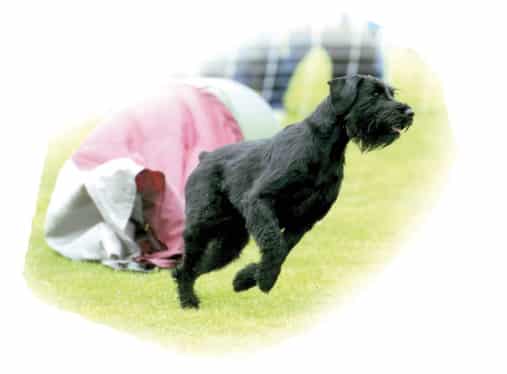
The tail is set moderately high and carried high in excitement. It should be docked to the second or not more than the third joint (approximately one and one-half to about three inches at maturity).
This section is very specific. The docked tail should consist of either two or three joints. No guideline was established for undocked tails by the authors of the standard, leading us to believe that the concept was either not considered or it was rejected. Keep in mind that the standard includes descriptions for both cropped and uncropped ears. An undocked tail is not a listed disqualification, so how should a judge treat an undocked tail? Refer to the section on faults: The foregoing description is that of the ideal Giant Schnauzer. Any deviation from the above described dog must be penalized to the extent of the deviation. Since a full tail is quite a deviation from two or three joints, it must be considered a serious fault. Keep in mind that the judges should be making their picks by considering how exhibits compare to the standard rather than through individual, personal tastes or convictions. Another common fault, discussed in the Illustrated Standard, is the gay or “squirrel” tail.
An undocked tail is NOT a disqualification. However, a person wishing to show an undocked Giant must understand that it is a fault that must be overcome with sufficient overall quality and breed type.
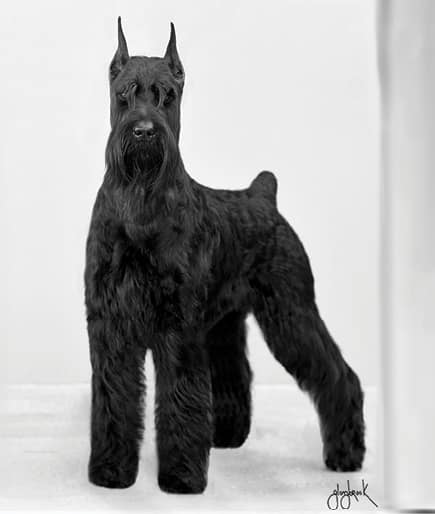
The hindquarters are strongly muscled, in balance with the forequarters; upper thighs are slanting and well bent at the stifles, with the second thighs (tibiae) approximately parallel to an extension of the upper neckline. The legs from the hock joint to the feet are short, perpendicular to the ground while the dog is standing naturally, and from the rear parallel to each other. The hindquarters do not appear over-built or higher than the shoulder. Croup full and slightly rounded.
We should always keep in mind the purpose for which this breed was developed; to drive cattle through the Bavarian Alps. Our Standard is predicated on that concept. The Giant must be strong and hardy enough to accomplish the assigned task. Dogs with weak or over-angulated rears cannot hold up over long days in rough terrain. A very common fault is sickle hocks. This is a product of incorrect bone lengths, and it greatly affects movement and stamina.
Feet – Well arched, compact and catlike, turning neither in nor out, with thick tough pads and dark nails.
This section is concise and to the point. Again, it describes what is necessary for a drover dog. Of course, the dark nails are a product of the strong pigment inherent in the breed.
Dewclaws – Dewclaws, if any, on hind legs should be removed; on the forelegs, may be removed.
No comment is necessary for this section.
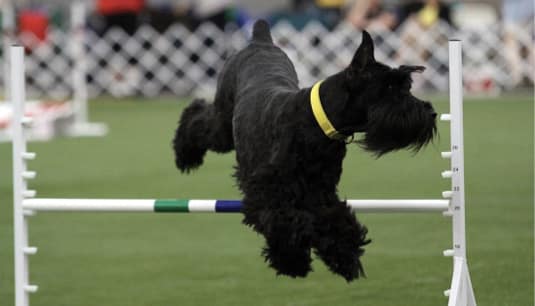
The trot is the gait at which movement is judged. Free, balanced and vigorous, with good reach in the forequarters and good driving power in the hindquarters. Rear and front legs are thrown neither in nor out. When moving at a fast trot, a properly built dog will single-track. Back remains strong, firm, and flat.
A trot is the working gait of the Giant. It was bred to work at this gait over rough terrain all day long. Efficient movement is absolutely necessary. Balance from front to rear is required to ensure the dog both reaches and drives. Common faults are poorly constructed fronts that flip or swing, and rears that have incorrect angles or long hocks. The back should be firm and flat when moving, though the topline may appear high-stationed while the dog is standing alert. The back is more likely to remain firm and flat when the dog is compact and balanced.
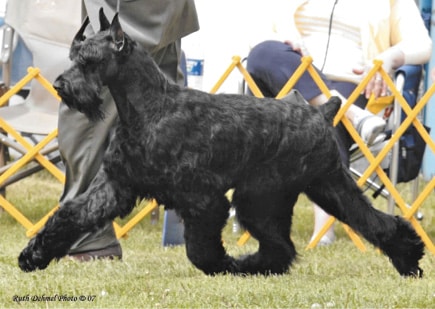
Hard, wiry, very dense; composed of a soft undercoat and a harsh outer coat which, when seen against the grain, stands slightly up off the back, lying neither smooth nor flat. Coarse hair on top of head; harsh beard and eyebrows, the Schnauzer hallmark.
Let’s delve into one important aspect of our Standard; the Coat. I’m not sure why this subject seems to engender the most debate or why it seems to be hard to understand. The Standard is quite clear in its description of the ideal Giant Schnauzer coat. Let’s go back to the origins of the Giant. This breed was developed in the Bavarian Alps to drive cattle and to protect livestock and the owners. Conditions and the elements predicated a serviceable coat to best protect the dogs while working.
Now let’s look at this a little more closely. It is a double coat. When the coat is correct, it will consist of both the softer, insulating undercoat and the harsh, protective outer coat. Both elements are necessary in order to meet the desired effect. Generally speaking, when the dog is single-coated with only top or outer coat, it will not likely have a lot of leg furnishings. Likewise, if a dog has only undercoat, it will likely possess profuse, soft furnishings. These two likelihoods are not written in stone. The real test is whether the body coat is correct. The aforementioned two sentence section on coat says what about furnishings? It simply states that the beard and eyebrows are harsh. No mention is made of furnishings or leg hair. The judge has no guidance to penalize for either having furnishings or not having them, and should not care whether or not they are present. My personal feeling is such; if an exhibit of mine has furnishings, I would prefer they be well-trimmed so as not to interfere with the judge’s ability to see the dog’s movement. If the dog doesn’t move very well coming at you, it may make sense to use furnishings to cover. However, if it moves like a Sunbeam Mixmaster, it’s probably best not to draw undue attention to this fact by having long, flowing furnishings blowing in the wind.
We all have personal preferences. I’ve heard people state that a particular breed, including our own, no longer performs the intended function or purpose for which it was originally bred. None of that matters when judging dogs. As I’ve stated, what matters is what the standard says pertaining to the breeds. Hair may be pretty to some, but not to others. “Pretty” is a personal perception, but it is not part of our standard. To me, a pretty Giant is one that looks like a one-piece dog where all the parts fit together smoothly in a moderate, functional way.
What’s important in the coat? “Hard, wiry, very dense; composed of a soft undercoat and a harsh outer coat…” Exclusion of either element is a fault.
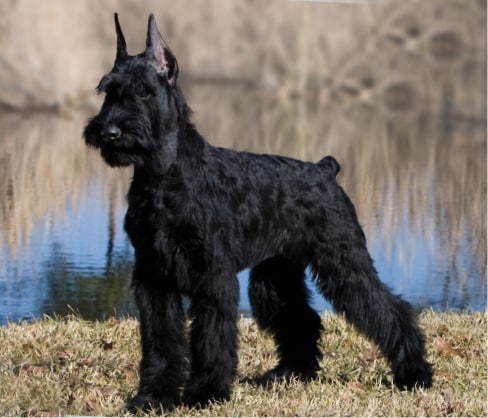
Solid black or pepper and salt.
Only two colors are accepted; Black, and Pepper and Salt.
Black – A truly pure black. A small white spot on the breast is permissible; any other markings are disqualifying faults.
The only marking allowed in the Black is a small spot on the chest. The Standard does not define what constitutes a small spot, so the guidance I offer is a spot approximately the size of a half dollar or smaller. Stray white hairs do not constitute a spot. An actual spot has white pigmentation in the skin below. White or silver stickle hairs are common in the Giant Schnauzer. These are hairs that appear sporadically in the coat and are basically a whisker. They are not considered a fault, regardless of how many the dog possesses.
Pepper and Salt – Outer coat of a combination of banded hairs (white with black and black with white) and some black and white hairs, appearing gray from a short distance. Ideally, an intensely pigmented medium gray shade with “peppering” evenly distributed throughout the coat, and a gray undercoat. Acceptable: all shades of pepper and salt from dark iron-gray to silver-gray. Every shade of coat has a dark facial mask to emphasize the expression; the color of the mask harmonizes with the shade of the body coat. Eyebrows, whiskers, cheeks, throat, chest, legs, and under tail are lighter in color but include “peppering.” Markings are disqualifying faults.
The Pepper and Salt coat is made up of banded hairs, which are black with white and white with black bands. The term for these banded hairs is “agouti.” These banded hairs are accompanied by black hairs and white hairs. This combination of colors produces a gray coloration from a distance. Any shade of gray is acceptable, but all Pepper and Salt Giant Schnauzers must exhibit a darker gray mask. Although the legs, under the throat, and other points are lighter in color, markings are not allowed. These lighter areas include “peppering” of darker hairs and, when closely examined, are not actual markings.
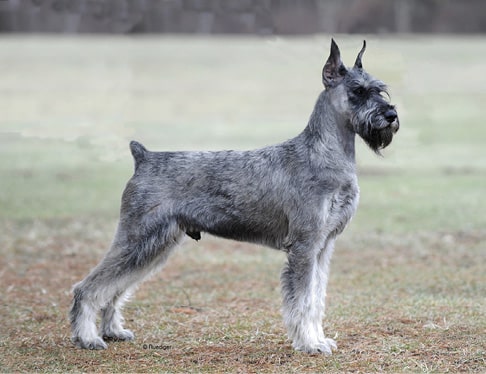
The height at the withers of the male is 25-1/2 inches to 27-1/2 inches, and of the female, 23-1/2 to 25-1/2 inches, with the mediums being desired. Size alone should never take precedence over type, balance, soundness, and temperament. It should be noted that too small dogs generally lack the power and too large dogs, the agility and maneuverability desired in the working dog.
The section concerning heights is short and simple. Bitches should be 23-1/2” to 25-1/2” at the withers while dogs should be 25-1/2” to 27-1/2” with the mediums being desired. The reason given for this average is strength, coupled with agility for the performance of duties.
Most of our Giants are either at the top of the standard or over. Keeping in mind that we are given a two-inch variance in each sex with mediums being desired, how much over the limit would be considered a serious fault? If we stretch the limit by another two inches, wouldn’t this be a serious deviation? This would probably constitute a serious fault, but we have to remember that the standard says that size alone should never take precedence over type, balance, soundness, and temperament. There is no measurement because there is no disqualification for size. Size is certainly a consideration in the overall judging process, and cannot be disregarded, but we seem to get plenty of latitude in this area.
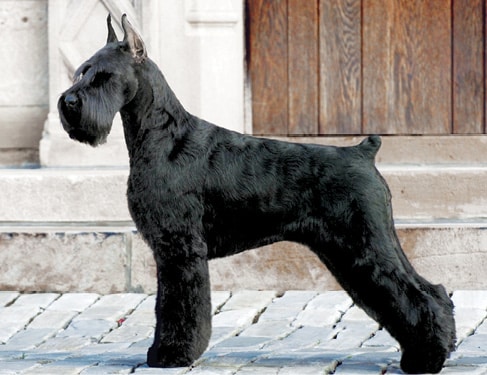
The foregoing description is that of the ideal Giant Schnauzer. Any deviation from the above described dog must be penalized to the extent of the deviation.
The judge shall dismiss from the ring any shy or vicious Giant Schnauzer.
This section of the the Giant Schnauzer Breed Standard deals with faults starting with the “extent of deviation” yardstick we use to determine how serious any particular fault should be considered.
Shyness – A dog shall be judged fundamentally shy if, refusing to stand for examination, it repeatedly shrinks away from the judge; if it fears unduly any approach from the rear; if it shies to a marked degree at sudden and unusual noises.
Viciousness – A dog that attacks or attempts to attack either the judge or its handler is definitely vicious. An aggressive or belligerent attitude towards other dogs shall not be deemed viciousness.
Overshot or undershot. Markings other than specified.
The Giant Schnauzer Breed Standard states that the judge SHALL dismiss from the ring any shy or vicious Giant Schnauzer and it succinctly defines both shyness and viciousness. Most judges will give a puppy more than one chance to stand for exam, and judges may use
discretion interpreting whether a dog is fundamentally shy. The disqualifications are few and are clearly stated, though markings can confuse newer judges. Hopefully, those questions were answered in the Coat and Color discussion.
Purebred dogs, in general, are breeds developed by humans to exhibit certain desired traits that set them apart from other breeds. These purebreds did not “happen into existence” purely by natural selection. Most physical traits are the product of genetics. Grooming, cropping, and docking aspects are distinctly controlled by the human hand. These issues were originally based on practical application rather than aesthetic value.
The written Standard for any breed is the blueprint for that breed. The Standard is in place to ensure that the traits associated with that breed are maintained in order to preserve that breed. The purpose of conformation judging is to choose the breeding stock that best exhibits those traits. The concept of conformation judging is simple: One person, serving as the judge while having a working understanding of that breed’s Standard, chooses the exhibits that best exemplify the image created by the written Standard. In any given competition, the Standard used is the particular Standard for that breed and is endorsed by the registry holding the event. In our case, the registry is the American Kennel Club. The judge is obligated to follow the Official Breed Standard to the best of his or her understanding.
The Breed Standard that we use was originally written by the Pinscher Schnauzer Klub in Germany. These were people who had a hand in the development of the breed. They had a vision of what the ideal Giant Schnauzer should look like and transferred this vision into written word. This breed was developed by humans to perform certain tasks on behalf of humans. This took place in a particular region of the world during a particular period in history.
To sum up this article, “type” is always the main consideration when judging. Knowing what constitutes type is the key to correctly choosing the best breeding stock. The Giant Schnauzer is a square-built dog of medium size with a rough coat, harsh beard and eyebrows, and a frame that supports trotting over rough terrain for hours. Not to be overlooked is the temperament. Temperament is featured in the General Description, the section on Size, and the section on Faults. Half of the General Description is devoted to the subject. Temperament is one of the most important factors in determining breed type and should NEVER be overlooked. If we lose temperament, we have lost the breed’s ability to work and, in effect, the breed.
All aspects of the Breed Standard point back to the breed’s original purpose. The history of the breed is the key to understanding the Standard.
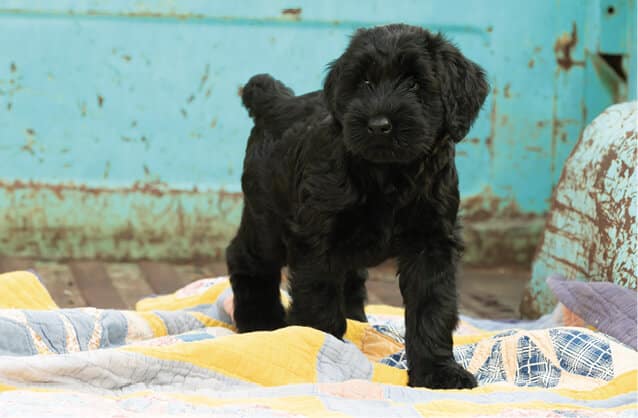
Photographs by: Thris Keck & Gay Glazbrook
